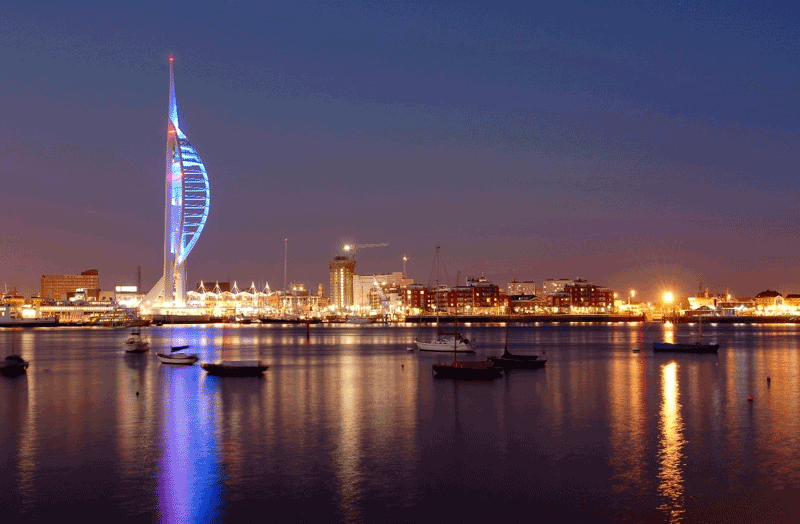Portsmouth City Council has led or supported cultural investment over two decades to transform closed naval sites into a major visitor and employment hub. This case study forms part of the Value of culture - regeneration section of our online Culture Hub.
Background and history
The 1981 recommendation to close naval sites at the Portsmouth dockyard led to significant job losses and the loss of an economic function for these areas. Gunwharf became an inaccessible, disused naval storage area.
In the late 1990s, a group of city organisations, including Portsmouth City Council, came together to develop a strategic vision for the area and submit a bid to the Millennium Commission for funding to support the renaissance of Portsmouth Harbour, initially receiving £40 million for investment activity. Over the subsequent two decades, this funding, alongside other public and private investment, has seen the development of the iconic Spinnaker tower, Gunwharf Quays retail outlet, the National Museum of the Royal Navy and the new Mary Rose Museum.
Timeline
- 1981 – Recommendation of closure of some naval sites at Portsmouth Dockyard
- 1997 – Planning applications for Gunwharf Quays submitted
- 2001 – Gunwharf Quays opens
- 2005 – Spinnaker Tower opens
- 2010 National Museum of the Royal Navy came into being, with a focus on naval heritage
- 2013 – New Mary Rose museum opens
Funding for Portsmouth cultural infrastructure
Gunwharf Quays: all private sector funding
Spinnaker Tower:
Portsmouth City Council – £11 million grants and contributions (including from the Millennium Commission)£27 million
Museum of the Royal Navy:
Heritage Lottery Fund – £14 million
other fundraising and donations
Mary Rose Museum:
Heritage Lottery Fund – £23 million
other sources £12 million
Delivery of activities
The collection of attractions in this area of Portsmouth attracts a broad range of local and external visitors to explore the museums and the Spinnaker Tower viewing platform, shop at the retail outlet and enjoy the space.
Having now delivered many key components of the earlier vision, the group continues to play a coordinating role, with an aim to support continued development and regeneration. This includes exploring new uses for old buildings and seeking to continually enhance the attractiveness of the area and the offer. This work has supported the development of a new creative quarter in the arches at Point Battery.
Impacts
|
250 jobs supported at Portsmouth Dockyard |
|
|
2 million new visitors spending £51 million each year |
|
|
Spinnaker Tower used extensively in Portsmouth marketing and to attract inward investment |
- 250 full-time equivalent (FTE) jobs supported – around 250 FTE people are directly employed at Portsmouth Historic Dockyard
- two million annual visitors – to Portsmouth Historic Dockyard, supporting long-term jobs in the visitor economy through £51 million of annual visitor spending
- catalyst for wider investment – including 350 new high-value jobs supported at Ben Ainslie Racing HQ
- enhanced image – the iconic Spinnaker Tower in particular has generated significant exposure for Portsmouth, and is used extensively in Portsmouth marketing and inward investment.
Learning points
Shared vision: the long-term regeneration of Portsmouth Harbour has required the energy, skills and commitment of a wide range of organisations, and so early work to develop a shared vision among partners provided a critical foundation for successful delivery. Securing private investment: as well as securing private investment into visitor attractions, the overall plans were underpinned by the private sector led Gunwharf Quays retail development, and continued growth of economic impacts will come from further development of new private workspace and employment in this area. Importance of coherent high-quality attractions: the quality and coherence of the suite of attractions has been very important in increasing and sustaining visitor numbers. The Mary Rose, for example, achieved second place in the 2018 European Museum of the Year award.
Portsmouth City Council saw an opportunity to regenerate the Gunwharf Quays area by opening up the waterfront, creating jobs, increasing visitor numbers and drawing in further investment. The area complements its neighbour, Portsmouth Historic Dockyard, which is the UK’s premier maritime heritage destination. “These destinations contribute hugely to the city’s economy and prestige and are excellent examples of how a local authority with a vision can work in partnership with the private sector, the Ministry of Defence and heritage agencies to achieve transformation.”
Councillor Gerald Vernon-Jackson, Leader, Portsmouth City Council

